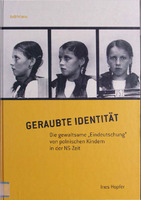Geraubte Identität
Die gewaltsame "Eindeutschung" von polnischen Kindern in der NS-Zeit
Author(s)
Hopfer, Ines
Collection
Austrian Science Fund (FWF)Language
GermanAbstract
Stolen identity - the forced "Germanization" of "racially valuable" children during National Socialism, illustrated by the country of Poland.
Heinrich Himmler, acting in his capacity as “Reich Commissioner for the Strengthening of German Foldom”, ordered the selection of "racially valuable" polish children for "Germanization" – the Teutonic blood had to be collected even if it meant kidnapping children.
For this reason polish children from orphanages, schools, forster parents, parents who refused to sign the “Volksliste” and parents who had been murdered or sent to forced labor or concentration camps had to have a "racial" examination – children who possessed the Nordic features were regarded as suitable for the “Germanization” and were distributed in special children homes. At these special children homes the children were forced to give up their own identity step by step: the children got new German names and had to learn German, moreover contact with relatives at home was painfully forbidden. In Austria, known as "Ostmark" during National Socialism, two special places were found, where polish children were confronted with "Germanization practices": the children home "Alpenland" in Oberweis next to Gmunden and the resettlement camp "Parsch" in Salzburg.
After a "successful Germanization" the children were placed in German and Austrian forster families. There the children were treated in different ways: some children became a part of the family, they felt safety and comfortable and were treated like their own children. Other polish girls and boys were treated badly: the forster families took advantage of their defencelessness, they abused and beat the polish children, they reagard them just as cheap labourer.
After the war only a small number of such kidnapped children was tracked by the several tracking services like UNRRA, IRO or the Polish Red Cross. But further problems arose when German and Austrian forster families or the children themselves opposed the repatriation to Poland. Being back in Poland, the polish children were regarded as children of the enemy – regarded as “German” of the polish society. Geraubte Identität. Die gewaltsame "Eindeuschung" von "rassisch vollen" Kindern in der NS-Zeit. Am Beispiel Polen.
In der vorliegenden Arbeit wird das Schicksal von polnischen Kindern in der NS-Zeit untersucht. Die Jungen und Mädchen wurden aufgrund ihres "rassischen" Erscheinungsbildes und eines psychologischen Gutachtens von namhaften Dienststellen des Deutschen Reiches als „eindeutschungsfähig“ bewertet und in die „Ostmark“ deportiert. Die Verantwortlichen des Verfahrens sahen in den Selektierten den erwünschten "wertvollen Bevölkerungszuwachs", die betroffenen Kinder mussten lediglich nationalsozialistisch indoktriniert werden, um die Ideale des NS-Regimes nicht nur äußerlich zu verkörpern. Polnische Jungen und Mädchen wurden aus Fürsorgeheimen, von ihren Vormündern und von ihren Pflegestellen fortgenommen, aus ihrem leiblichen Elternhaus sowie aus Familien, die die Eintragung in die DVL verweigerten oder ins Konzentrationslager gebracht worden waren, regelrecht verschleppt. Im Laufe ihres Leidensweges mussten sich die Kinder einem strengen Auswahlverfahren unterziehen und wurden mit spezifischen „Eindeutschungsmaßnahmen“, wie der „Verdeutschung“ des Namens oder dem Erlernen der deutschen Sprache konfrontiert. Die Betroffenen wurden somit schrittweise ihrer ursprünglichen Identität entledigt.
In der „Ostmark“ wurde in der Nähe von Gmunden eigens ein Heim für „einzudeutschende“ Jungen und Mädchen errichtet – das Kinderheim „Alpenland“ in Oberweis, das eine zentrale Schaltstelle für die Vermittlung „einzudeutschender“ Kinder an Pflegestellen in der „Ostmark“ darstellte. Daneben ist noch das Umsiedlerlager „Parsch“ in Salzburg zu nennen, in dem auch „eindeutschungsfähige“ Jungen und Mädchen kurzfristig untergebracht und an Pflegefamilien im Raum Salzburg übergeben wurden.
Die Vermittlung an eine deutsche bzw. österreichische Pflegefamilie stellte den „krönenden Abschluss“ der „Eindeutschungsverfahrens“ dar. Die Integration in diese „Ersatzfamilien“ verlief allerdings unterschiedlich: So wurden einige Kinder von ihren Pflegestellen als Arbeitskräfte ausgenutzt, andere Familien hingegen gaben den ausländischen Pflegekindern ein herzliches Zuhause. Infolgedessen lehnten so manche Jungen und Mädchen nach Kriegsende die Repatriierung in ihre ursprüngliche Heimat ab. Das Auffinden der polnischen Kinder war für die diversen Suchdienste nach Kriegsende mit enormen Schwierigkeiten und bürokratischen Hindernissen verbunden, nur ein Bruchteil der Kinder konnte gefunden werden. Für viele stellte die Rückführung in die Heimat allerdings eine seelische Belastung dar: Die Kinder wurden mit Vorurteilen der Nachkriegsbevölkerung konfrontiert und wurden zu Außenseitern degradiert.
Keywords
Germanization; National Socialism; children homes; Polish Children; Kidnapping; "Ostmark"; Germanization; National Socialism; children homes; Polish Children; Kidnapping; "Ostmark"; Heimerziehung; Lebensborn; Polen; SchutzstaffelDOI
10.26530/oapen_437141ISBN
9783205784623OCN
755083478Publication date and place
2010Grantor
Imprint
BöhlauClassification
History


 Download
Download